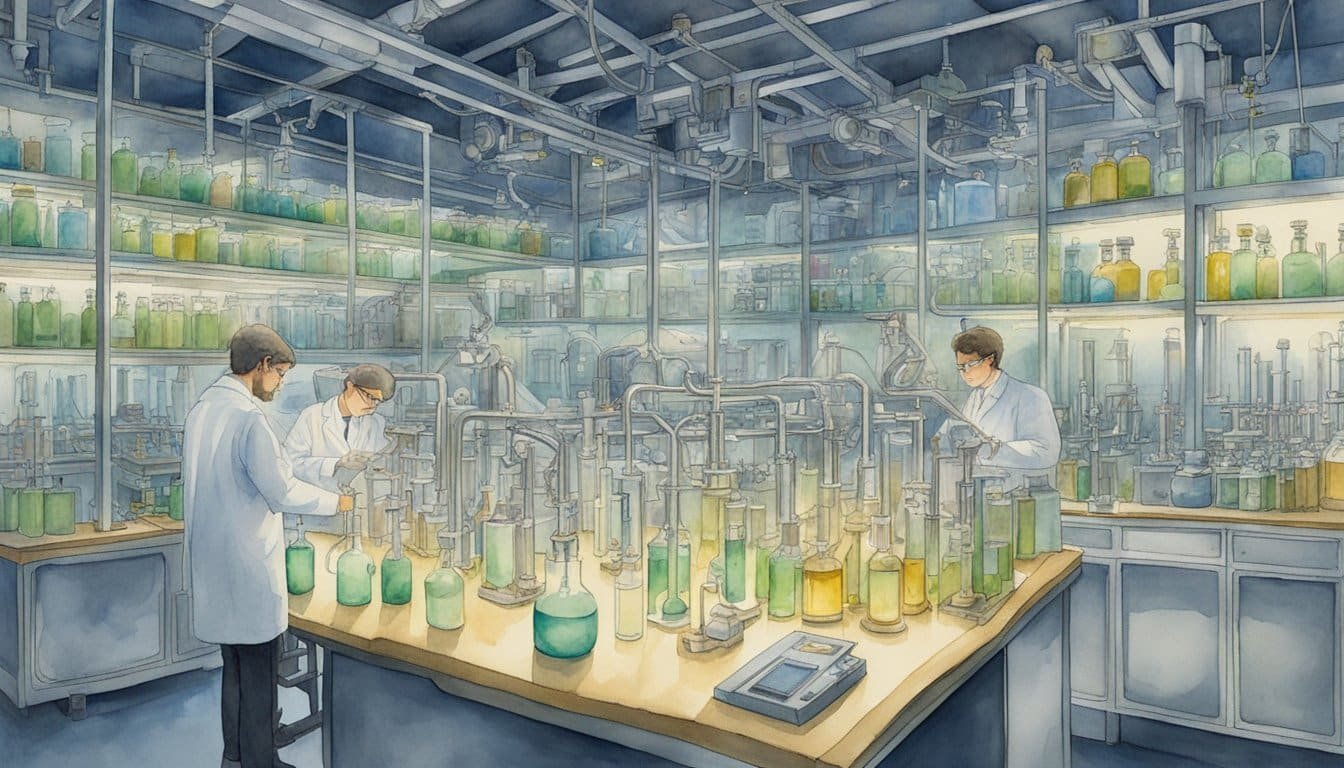Understanding Strange Matter
Strange matter, a fascinating subject in particle physics, is not your everyday material. It’s theorized to be composed of an equal number of up, down, and strange quarks. Unlike the atoms familiar to us, with a nucleus surrounded by electrons, strange matter doesn’t play by the usual rules.
In the quantum chromodynamics realm, which is the science of how quarks interact via the strong force, strange matter appears to be a stable configuration under immense pressure. This transformation of ordinary matter into strange matter would involve compressing nuclei so tightly that the individual hadrons (like protons and neutrons) dissolve into a “soup” of quarks.
Why does this matter? Because neutron stars, some of the densest objects in the universe, might be where this bizarre state of matter naturally occurs. As these stars collapse, their cores may reach densities high enough for compression to kick in, possibly forming strange stars—a whole star made of strange matter!
Interestingly, strange matter could be more stable than the matter making up everything around us. Nuclear physicists ponder if a tiny bit of it could theoretically convert regular matter into more strange matter upon contact. But don’t worry—no evidence suggests it’s a risk to us!
Let’s break it down:
- Atoms: Usually have a nucleus and electrons.
- Strange Matter: A strange quark mash-up potentially more stable than regular atoms.
- Strong Interaction: The force that would bind quarks together in strange matter.
- Neutron Stars: Potential cosmic producers of natural strange matter.
The study of strange matter is a thrilling chapter in science that challenges our understanding of the building blocks of the universe. It’s a vivid reminder that reality can be stranger than fiction, especially when you dive into the quantum world!
Fundamental Particles and Quark Combinations
In the heart of every atom, the stage is set for a dance of subatomic particles, robust in their complexity. This particle jamboree isn’t just a display of science—it crafts the very fabric of space and matter.

Quarks and the Building Blocks of Matter
Quarks are the quintessential components that make up protons, neutrons, and other particles inside atomic nuclei. There are six flavors of quarks: up, down, charm, strange, top, and bottom. For everyday matter, it’s mostly up quarks and down quarks that run the show, teaming up in trios to form the protons and neutrons that give atoms their mass and personality. On occasion, strange quarks drop in to spice up the mix, forming exotic relatives like lambda particles and theorized strangelets.
| Quark Flavor | Common Pairing | Role in the Nucleus |
|---|---|---|
| Up | 2 up, 1 down | Proton |
| Down | 2 down, 1 up | Neutron |
| Strange | Varies | Exotic matter |
Pivoting around these quarks are gluons, the sticky-handed brokers of the strong force, always ensuring quarks stay bound together under intense pressure.
Interactions and Forces Among Particles
Within the realm of the infinitesimally small, forces govern the rules, with the strong force being the supreme regulator among subatomic particles. Operating like cosmic glue, it’s this force that locks quarks into forming nucleons (protons and neutrons). When it’s not tying quarks together, the strong force resides within nuclei, making sure these tiny clusters don’t fly apart.
On the other side, you have the electromagnetic force, chiefly in charge of the push and pull between electrically charged particles. It’s less about holding things together and more about stirring the pot, creating reactions that give us everything from the touch of a hand to the light of the sun.
This symphony of forces and particles doesn’t only conduct science here on Earth but also orchestrates the vastness of space, revealing that the elemental rules we find locally apply universally.
Experiments and Discoveries

In the realm of particle physics, the quest to understand the fundamental building blocks of the universe often leads to the bizarre and the wondrous, with strange matter standing out in its elusiveness and peculiar properties. This section delves into the key experimental milestones and the specialized locations where the veil of mystery surrounding strange matter is slowly being lifted.
Laboratories and Facilities
The Thomas Jefferson National Accelerator Facility, more commonly known as Jefferson Lab, and the Brookhaven National Laboratory are two of the bastions of modern physics pushing the envelope. These institutions are part of the U.S. Department of Energy’s network of research facilities. With the DOE Office of Science’s support, Jefferson Lab’s Continuous Electron Beam Accelerator Facility enables scientists to peer into the core of atomic nuclei, unleashing high-powered beams of electrons to jostle the internal components, observing how protons and neutrons behave under stress. Meanwhile, Brookhaven’s Relativistic Heavy Ion Collider ponders the likes of lead and iron at extremes of temperature and density, simulating conditions akin to a neutron star’s crust, where strange matter could naturally occur.
Significant Experimental Data
Physics journals are often abuzz with findings hinting at the peculiarities of strange matter. One highlight is the reports in Physical Review Letters capturing head-on collisions of high-energy particles that skirt the edge of becoming a strange matter state. Data originating from Mississippi State University and Argonne National Laboratory add to a growing dataset that teases physicists searching for quirks in proton momentum or deviations in neutron star density. Each experiment and subsequent observation edges the scientific community closer to a profound understanding of how matter’s most foundational elements—like carbon and water—all minute reflections of the atom’s heart, could fit in a cosmos potentially teeming with strange matter.
Theory and Analysis

As we unravel the subatomic symphony playing within the heart of matter, the role of strange matter offers a fascinating glimpse into the core principles of the universe. From the tiniest components within a proton to the densest stars dotting the cosmos, it all boils down to a complex and incredibly strong force.
Quantum Chromodynamics and Hadronic Matter
Quantum Chromodynamics (QCD) sits at the epicenter of understanding hadronic matter. It’s the theory that focuses on the interaction between quarks and gluons, the fundamental particles that, when glued together by the strong interaction, form hadrons—protons and neutrons being the most familiar of these. Quarks come in six flavors, including the intriguing ‘strange quark,’ and QCD offers a window into how these flavors combine to form not just conventional diquarks but potentially more exotic combinations. For instance, when exploring dense matter, like in a neutron star, hadrons may dissolve into a soup of quarks and gluons, pointing to the existence of strange matter—a state of matter so mind-bending that it could rewrite the rules on how matter operates under extreme pressures.
Implications for Astrophysics
Delving into the cosmos, the study of strange matter isn’t just quantum navel-gazing; it has real implications for astrophysics. If neutron stars can convert into strange stars, this could provide insights into some of the most persistent puzzles of the cosmos. Researchers like Lamiaa El Fassi, an associate professor in physics, lead the charge in using clues scattered across the universe to understand these bizarre transitions. They suggest that the exotic properties of diquarks in dense environments could reveal new forms of cosmic phenomena, transforming our perception of the universe and the exotic matter that hides within some of its most mysterious objects.
Research and Technology

Strange matter is a curious state of matter that has intrigued scientists for decades. This exotic form of matter is thought to consist of approximately equal numbers of up, down, and strange quarks. To study strange matter, technology plays a crucial role, especially tools like particle accelerators and sophisticated detectors.
Researchers employ powerful particle accelerators such as the Continuous Electron Beam Accelerator Facility (CEBAF). This facility generates an electron beam that can be used to probe the internal structure of matter. Similarly, the anticipated Electron-Ion Collider will further extend our understanding of matter’s intricate properties.
Within these facilities, experiments such as the EG2 experiment of the CLAS Collaboration use a large acceptance spectrometer known as the CLAS detector. These experiments involve semi-inclusive deep inelastic scattering, where electrons collide with targets, allowing scientists to study the resulting debris to infer the presence of strange quarks.
Moreover, particle accelerators serve as high-powered microscopes, revealing details of particles like charm and top quarks, which are heavier cousins of the strange quark. The study of such particles often requires the consideration of them as free particles, despite the strong force binding them inside atomic nuclei.
| Key Component | Function |
|---|---|
| CEBAF | Accelerates continuous electron beams for collisions. |
| Electron-Ion Collider | Aimed to provide more in-depth exploration of nuclear matter. |
| CLAS Detector | Detects particles resulting from collisions for analysis. |
| Semi-Inclusive DIS | A method to study the quark-gluon structure of nucleons. |
| Particle Accelerator | Provides a high-energy environment necessary for quark studies. |
Capturing evidence of strange matter, or even hints of its existence, is a monumental challenge. It’s like searching for a cosmic needle in a haystack, but with such advanced technologies at their disposal, researchers are more equipped than ever to uncover the mysteries of the universe, one quark at a time.

